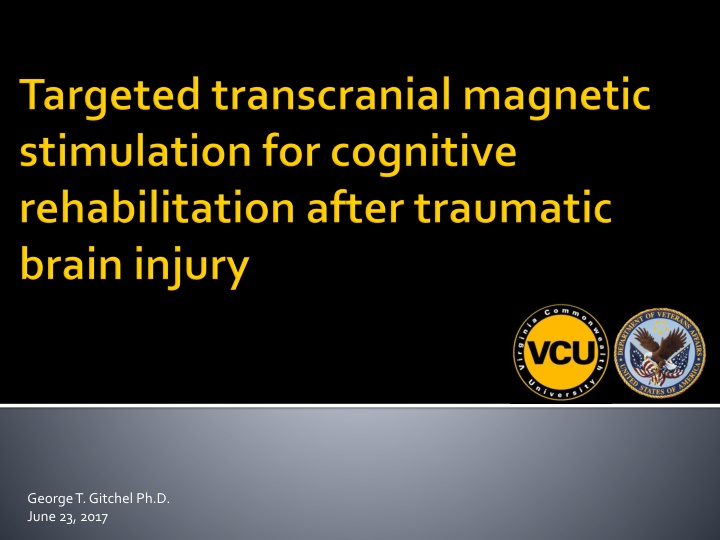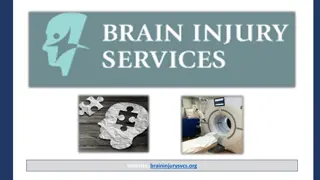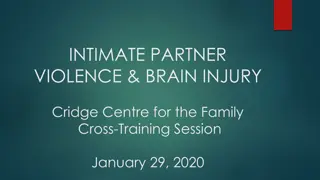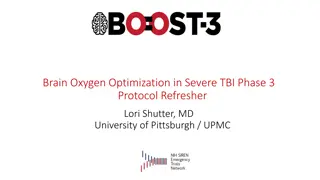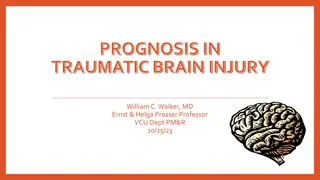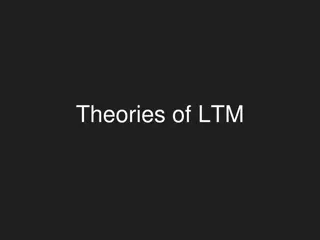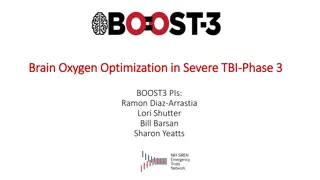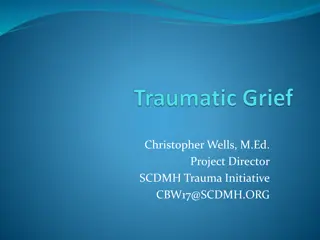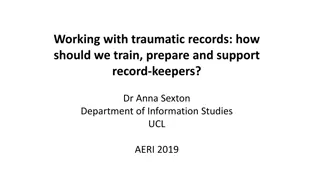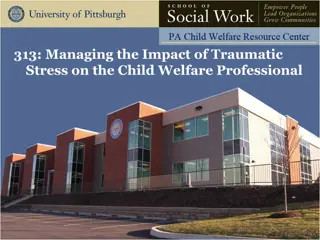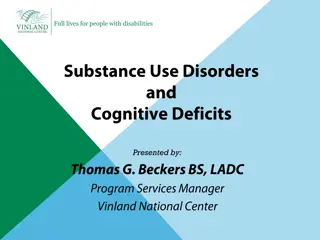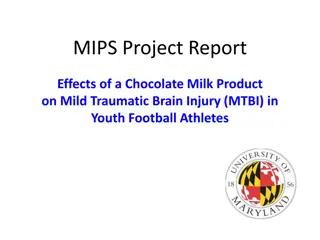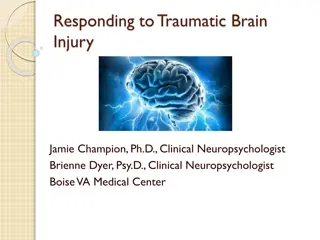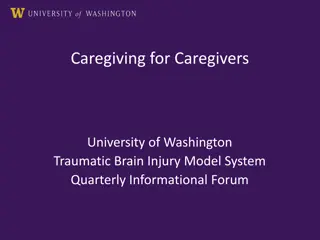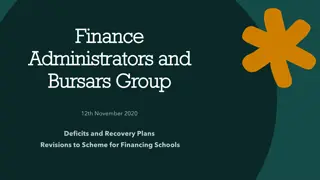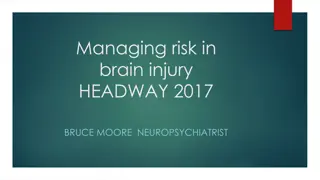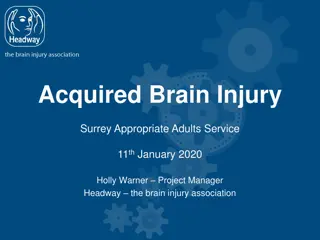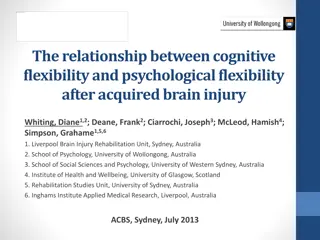Traumatic Brain Injury Cognitive Deficits and Intervention Challenges
Severe traumatic brain injuries (TBI) can lead to cognitive deficits such as communication difficulties, sensory deficits, neurobehavioral and emotional problems, among others. Current interventions for remediating cognitive deficits after TBI are limited, with compensatory strategies being commonly used. Pharmaceutical therapies offer only limited potential, and repetitive transcranial magnetic stimulation (rTMS) has shown some promise but requires further research. EEG frequency shifts are observed in TBI and other cognitive conditions like Alzheimer's disease and schizophrenia. More studies are needed to understand and address cognitive outcomes after TBI.
Download Presentation

Please find below an Image/Link to download the presentation.
The content on the website is provided AS IS for your information and personal use only. It may not be sold, licensed, or shared on other websites without obtaining consent from the author.If you encounter any issues during the download, it is possible that the publisher has removed the file from their server.
You are allowed to download the files provided on this website for personal or commercial use, subject to the condition that they are used lawfully. All files are the property of their respective owners.
The content on the website is provided AS IS for your information and personal use only. It may not be sold, licensed, or shared on other websites without obtaining consent from the author.
E N D
Presentation Transcript
George T. Gitchel Ph.D. June 23, 2017
TRAUMATIC BRAIN INJURY SEQUELAE ~25,000 adults with new TBI/year ~50,000 with long term complications Communication difficulty Sensory deficits Neurobehavioral Emotional problems Personality changes Psychiatric illness Cognitive deficits Most common initial and persistent symptom of TBI Signature injury of middle east wars 2
No well-supported intervention available to remediate/rebuild cognitive deficits after TBI Compensatory strategies are typically used Pharmaceutical therapies offer only limited potential for improvement (Osier, 2015; Warden, 2006) Repetitive transcranial magnetic stimulation (rTMS) has shown some promise in improving cognition in persons with neurologic and psychiatric disorders (Nadeau, 2014; Demirtas-Tatlidede, 2013; Guse 2010) Case reports of cognitive outcomes after rTMS in TBI are encouraging (Dhaliwal, 2015) More controlled studies are necessary
Severe TBI -> shifts in EEG frequency -> reduced consciousness (Schiff, 2014) Other cognitive deficits (Alzheimer s disease, schizophrenia), also exhibit similar changes in EEG frequency (Babilioni, 2006; Paus, 1999, Gattaz, 1992) Shifts of EEG frequency come from changes in the communication between large groups of cortical neurons Our team previously examined EEG changes after mild TBI in Veterans Found similar pattern of prefrontal EEG slowing (Franke, 2016)
VENTRAL LEFT RIGHT Right prefrontal and temporal increases in EEG delta activity were associated with a history of mTBI with posttraumatic amnesia (median 11 months since worst injury) compared to no mTBI DORSAL Franke et al., 2016
High frequency TMS (>1Hz) depolarizes (activates) neurons under the stimulating coil (Haraldsson, 2004) Prefrontal rTMS stimulation at 10Hz shown to decrease prefrontal and temporal delta activity: We found a significant decrease of delta and theta power on left prefrontal electrodes, mainly localized in the left DLPFC (Wozniak-Kwasniewska, 2014) EEG frequency bands were changed fronto-temporally (right) and were mainly decreases in delta and beta and increases in alpha1-activity (Jandl, 2005) After treatment, the resting electroencephalography revealed a significant decrease in the delta-band activity, which originated in the right prefrontal cortex and correlated with improvements in facial affect recognition. (Kamp, 2016)
TBI and cognitive deficits are correlated with increased delta activity rTMS has been shown to reduce delta activity in many conditions We hypothesize that rTMS stimulation will reduce delta activity, thereby inducing sustained increases in cortical excitability, thus improving attention and learning 7
Determine efficacy of rTMS on : 1. Objective measures of attention, learning and cognitive control 2. Neurophysiological measures of resting state CNS function 3. Self-reported symptoms 4. Cognitive and functional potential 5. Practical utility and feasibility of using rTMS in a TBI population 8
Ruff 2 and 7 Selective attention test DKEFS Verbal Fluency Test California Verbal Learning test 2 10 minute resting EEG Event related potentials Cortical excitability (i.e. motor threshold) Neurobehavioral symptom inventory (NSI) Mild brain injury atypical symptom scale (MBIAS) Pittsburg Sleep quality index (PSQI) Clinician administered PTSD scale 5 (CAPS-5) Patient health questionnaire (PHQ-9) PROMIS short form pain scale McGill Pain questionnaire short form Traumatic brain injury quality of life (TBI-QOL) General self efficacy scale (GSE) 9
MRI navigated, EMG calibrated Focal stimulation High frequency stimulation possible Navigation ensures consistency 13
Based on our findings and the previously reviewed literature, high frequency (10Hz) stimulation of the right frontal cortex (site of EEG changes) was chosen Stimulation duration and inter-train intervals were chosen to remain at the low end of recommended safety parameters due to TBI population Similar parameters have been used in a PTSD population with no adverse psychological effect (Cohen, 2004)
All VA related hurdles overcome Research coordinator and EEG tech interviewed and hired. New IRB protocol submitted 1st round of contingencies re-submitted Anticipate enrollment by Aug 1. 15
Woniak-Kwaniewska A, Szekely D, Aussedat P, Bougerol T, David O. Changes of oscillatory brain activity induced by repetitive transcranial magnetic stimulation of the left dorsolateral prefrontal cortex in healthy subjects. Neuroimage. 2014;88:91 99. Nielson DM, McKnight CA, Patel RN, Kalnin AJ, Mysiw WJ. Preliminary guidelines for safe and effective use of repetitive transcranial magnetic stimulation in moderate to severe traumatic brain injury. Arch Phys Med Rehabil. 2015;96(4):S138 S144. Rossi S, Hallett M, Rossini PM, Pascual-Leone A, Group S of TC, others. Safety, ethical considerations, and application guidelines for the use of transcranial magnetic stimulation in clinical practice and research. Clin Neurophysiol. 2009;120(12):2008 2039. Pascual-Leone A, Houser CM, Reese K, et al. Safety of rapid-rate transcranial magnetic stimulation in normal volunteers. Electroencephalogr Clin Neurophysiol Potentials Sect. 1993;89(2):120 130. CFR. Code of Federal Regulations Title 21 CFR882.5805 Part 882-Neurological Devices; Subpart F Therapeutic Devices; Sec.882.5805 Repetitive Transcranial Magnetic Stimulation. https://www.accessdata.fda.gov/scripts/cdrh/cfdocs/cfcfr/cfrsearch.cfm?fr=882.5805. Accessed March 24, 2016. Faul F, Erdfelder E, Lang AG, Buchner A. G* Power 3: A flexible statistical power analysis program for the social, behavioral, and biomedical sciences. Behav Res Methods. 2007;39(2):175 191. Walker WC, Cifu DX, Hudak AM, Goldberg G, Kunz RD, Sima AP. Structured Interview for Mild Traumatic Brain Injury after Military Blast: Inter-Rater Agreement and Development of Diagnostic Algorithm. J Neurotrauma. 2015;32(7):464 473. The management of Concussion/mTBI Working Grou, Department of Veterans Affairs. VA/DoD Clinical Practice Guideline for the Management of Concussion/Mild Traumatic Brain Injury (MTBI).; 2009. http://www.healthquality.va.gov/guidelines/Rehab/mtbi/concussion_mtbi_full_1_0.pdf. Ruff RM, Niemann H, Allen CC, Farrow CE, Wylie T. The Ruff 2 And 7 Selective Attention Test-A Neuropsychological Application. Percept Mot Skills. 1992;75(3f):1311 1319. Delis DC, Kaplan E, Kramer JH. Delis-Kaplan Executive Function System (D-KEFS). San Antonio, TX: The Psychological Corporation; 2001. Delis DC. California Verbal Learning Test. Psychological Corporation; 2000. Luck SJ. Event-related potentials. In: Cooper H, Camic PM, Long DL, Panter AT, Rindskopf D, Sher KJ, eds. APA Handbook of Research Methods in Psychology, Vol 1: Foundations, Planning, Measures, and Psychometrics. Washington: American Psychological Association; 2012:523-546. http://content.apa.org/books/13619-028. Accessed February 5, 2016. Cicerone KD, Kalmar K. Persistent postconcussion syndrome: The structure of subjective complaints after mild traumatic brain injury. J Head Trauma Rehabil. 1995;10(3):1-17. doi:10.1097/00001199-199510030-00002. Cooper DB, Nelson L, Armistead-Jehle P, Bowles AO. Utility of the Mild Brain Injury Atypical Symptoms Scale as a Screening Measure for Symptom Over-Reporting in Operation Enduring Freedom/Operation Iraqi Freedom Service Members with Post- Concussive Complaints. Arch Clin Neuropsychol. 2011. Buysse DJ, Reynolds CF, Monk TH, Berman SR, Kupfer DJ. The Pittsburgh Sleep Quality Index: a new instrument for psychiatric practice and research. Psychiatry Res. 1989;28(2):193 213. Huber R, Esser SK, Ferrarelli F, Massimini M, Peterson MJ, Tononi G. TMS-induced cortical potentiation during wakefulness locally increases slow wave activity during sleep. PLoS One. 2007;2(3):e276. Blake DD, Weathers FW, Nagy LM, et al. The development of a clinician-administered PTSD scale. J Trauma Stress. 1995;8(1):75 90. Kroenke K, Spitzer RL, Williams JB. The PHQ-9: validity of a brief depression severity measure. J Gen Intern Med. 2001;16(9):606- 613. Cella D, Riley W, Stone A, et al. The Patient-Reported Outcomes Measurement Information System (PROMIS) developed and tested its first wave of adult self-reported health outcome item banks: 2005 2008. J Clin Epidemiol. 2010;63(11):1179 1194. Melzack R. The short-form McGill Pain Questionnaire. Pain. 1987;30(2):191-197. Tulsky DS, Kisala PA, Victorson D, et al. TBI-QOL: Development and Calibration of Item Banks to Measure Patient Reported Outcomes Following Traumatic Brain Injury. J Head Trauma Rehabil. 2016;31(1):40-51. doi:10.1097/HTR.0000000000000131. Schwarzer R, Jerusalem M. R.(1995). Generalized self-efficacy scale. J Weinman Wright M Johns Meas Health Psychol Users Portf Casual Control Beliefs.:35 37. Anderson B, Mishory A, Nahas Z, et al. Tolerability and safety of high daily doses of repetitive transcranial magnetic stimulation in healthy young men. J ECT. 2006;22(1):49 53. Angeleri F, Majkowski J, Cacchio G, et al. Posttraumatic Epilepsy Risk Factors: One-Year Prospective Study After Head Injury. Epilepsia. 1999;40(9):1222 1230. Reti IM, Schwarz N, Bower A, Tibbs M, Rao V. Transcranial magnetic stimulation: A potential new treatment for depression associated with traumatic brain injury. Brain Inj. 2015;29(7-8):789-797. doi:10.3109/02699052.2015.1009168. Diamond PT. Brain injury in the Commonwealth of Virginia: an analysis of Central Registry data, 1988-1993. Brain Inj. 1996;10(6):413-420. doi:10.1080/026990596124278. Virginia Brain Injury Council. Neurobehavioral Treatment for Virginians with Brain Injury: A Virginia Brain Injury Council Position Paper. Virginia Department of Rehabilitative Services; 2010. http://www.vadars.org/cbs/biscis.htm. Accessed February 5, 2016. Ettenhofer ML, Melrose RJ, Delawalla Z, Castellon SA, Okonek A. Correlates of Functional Status Among OEF/OIF Veterans With a History of Traumatic Brain Injury. Mil Med. 2012;177(11):1272-1278. doi:10.7205/MILMED-D-12-00095. Whyte J, Hart T, Vaccaro M, et al. Effects of methylphenidate on attention deficits after traumatic brain injury: a multidimensional, randomized, controlled trial. Am J Phys Med Rehabil. 2004;83(6):401. Warden DL, Gordon B, McAllister TW, et al. Guidelines for the Pharmacologic Treatment of Neurobehavioral Sequelae of Traumatic Brain Injury. J Neurotrauma. 2006;23(10):1468- 1501. doi:10.1089/neu.2006.23.1468. Osier ND, Dixon CE. Catecholaminergic based therapies for functional recovery after TBI. Brain Res. 2015. http://www.sciencedirect.com/science/article/pii/S0006899315009658. Accessed February 5, 2016. Schwedt TJ, Vargas B. Neurostimulation for treatment of migraine and cluster headache. Pain Med. 2015;16(9):1827 1834. Demirtas-Tatlidede A, Vahabzadeh-Hagh AM, Pascual-Leone A. Can noninvasive brain stimulation enhance cognition in neuropsychiatric disorders? Neuropharmacology. 2013;64:566-578. doi:10.1016/j.neuropharm.2012.06.020. Nadeau SE, Bowers D, Jones TL, Wu SS, Triggs WJ, Heilman KM. Cognitive Effects of Treatment of Depression with Repetitive Transcranial Magnetic Stimulation: Cogn Behav Neurol. 2014;27(2):77-87. doi:10.1097/WNN.0000000000000031. Wang JX, Rogers LM, Gross EZ, et al. Targeted enhancement of cortical-hippocampal brain networks and associative memory. Science. 2014;345(6200):1054 1057. Dhaliwal SK, Meek BP, Modirrousta MM. Non-Invasive Brain Stimulation for the Treatment of Symptoms Following Traumatic Brain Injury. Front Psychiatry. 2015;6. doi:10.3389/fpsyt.2015.00119. Franke LM, Walker WC, Hoke KW, Wares JR. Distinction in EEG slow oscillations between chronic mild traumatic brain injury and PTSD. Int J Psychophysiol. 2016;106:21 29. Schiff ND, Nauvel T, Victor JD. Large-scale brain dynamics in disorders of consciousness. Curr Opin Neurobiol. 2014;25:7 14. Paus T, Zatorre RJ, Hofle N, et al. Time-related changes in neural systems underlying attention and arousal during the performance of an auditory vigilance task. Cogn Neurosci J Of. 1997;9(3):392 408. Pascual-Leone A, Valls-Sol J, Wassermann EM, Hallett M. Responses to rapid-rate transcranial magnetic stimulation of the human motor cortex. Brain. 1994;117(4):847 858. Pascual-Leone A, Amedi A, Fregni F, Merabet LB. The plastic human brain cortex. Annu Rev Neurosci. 2005;28:377 401.
